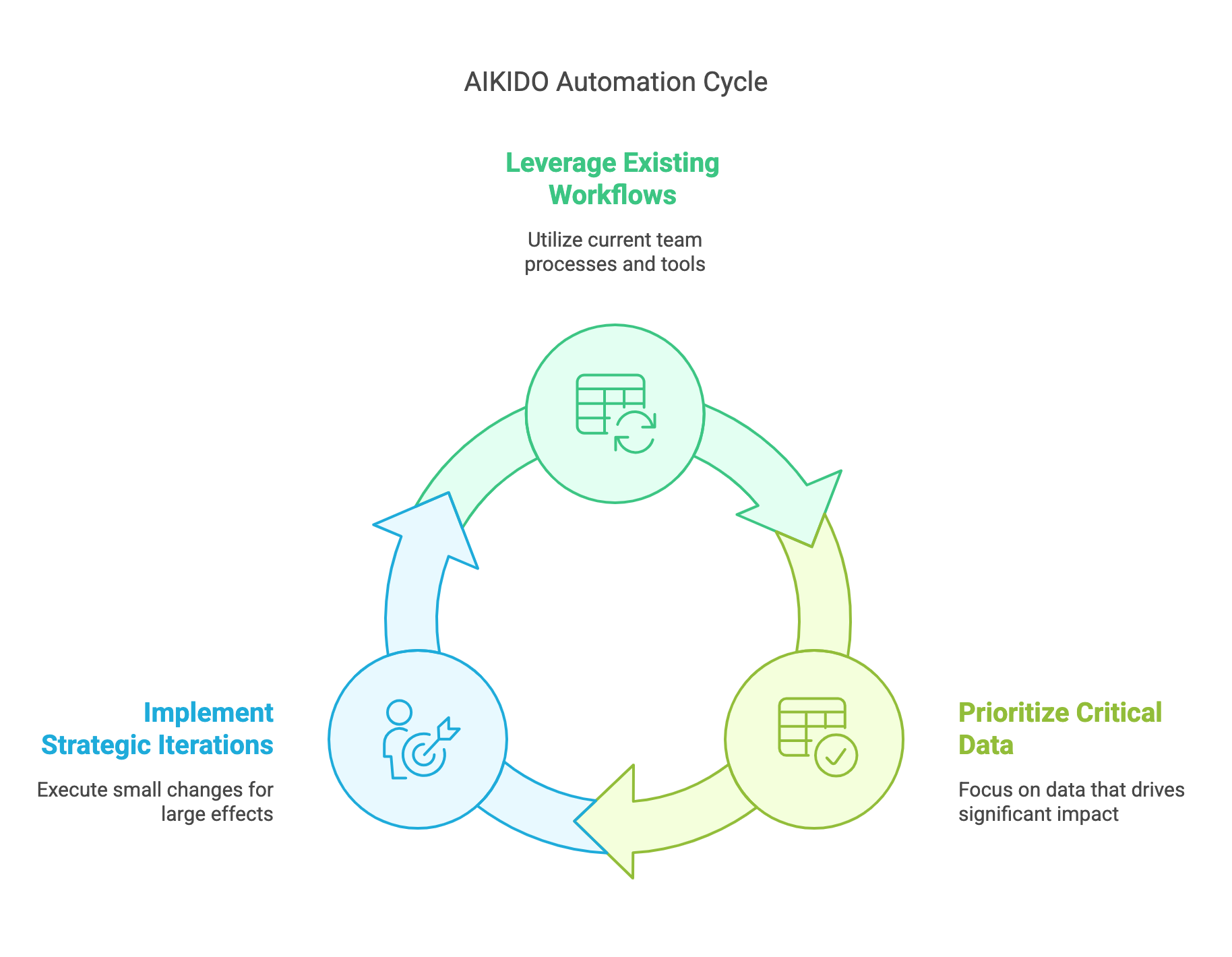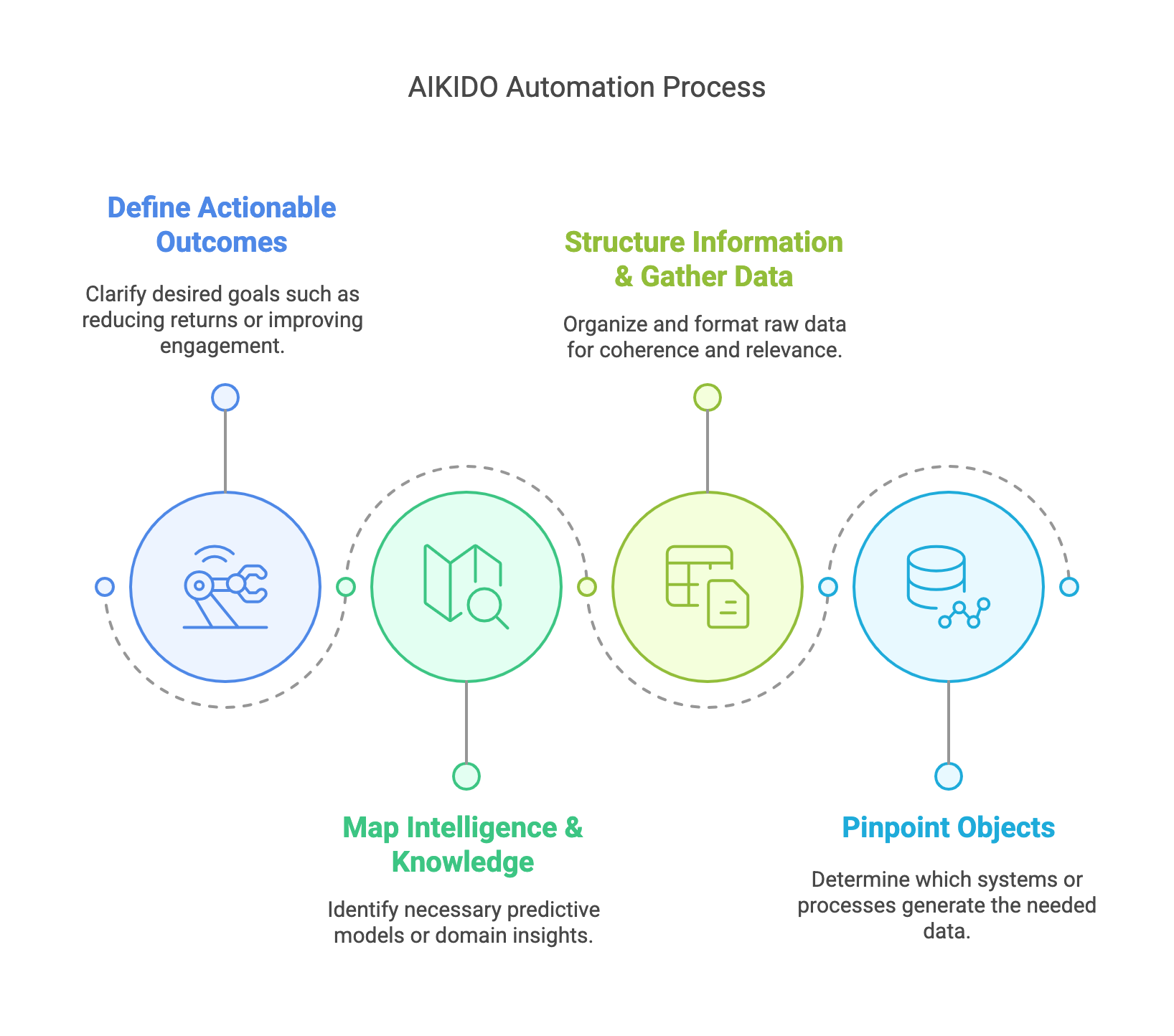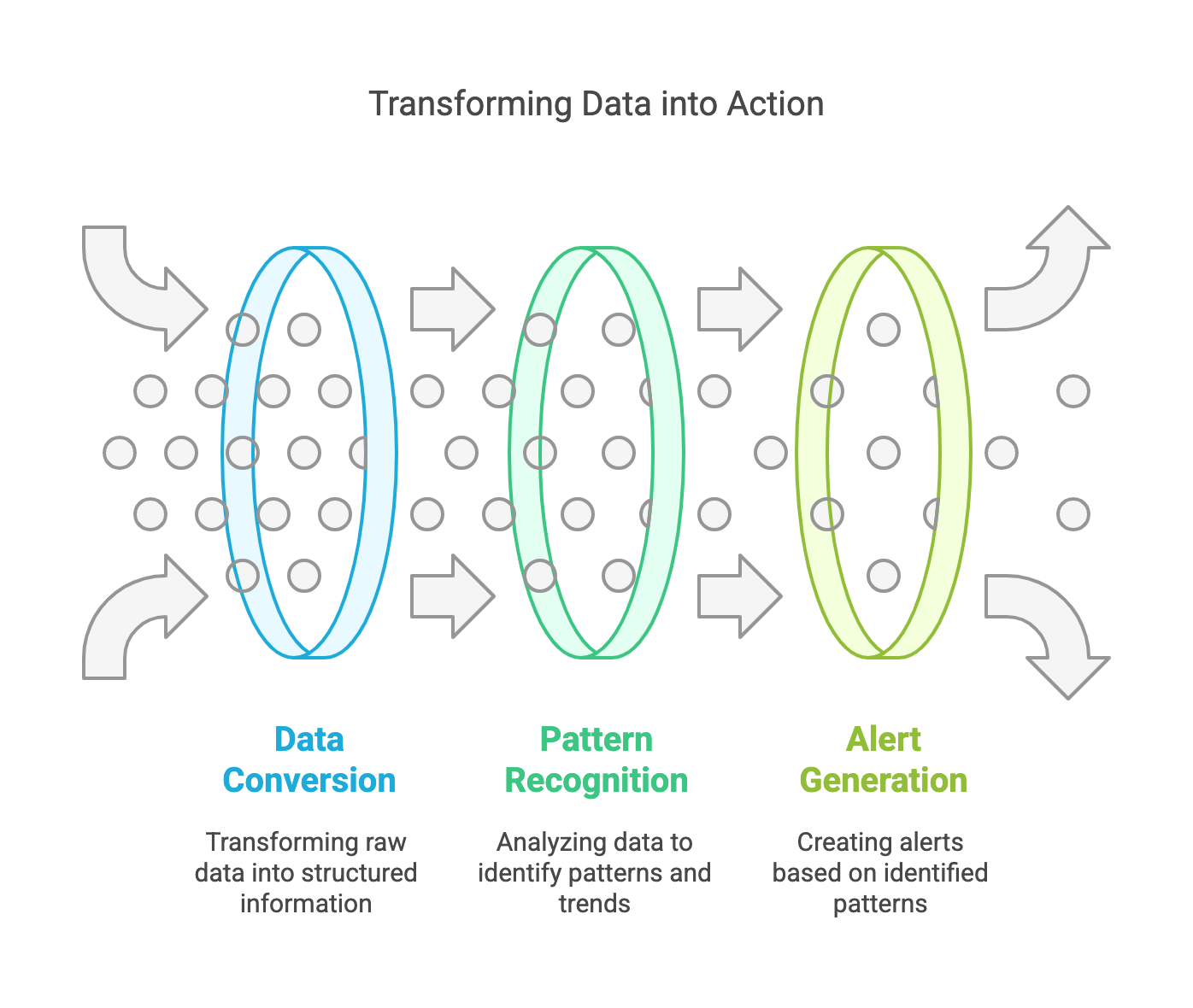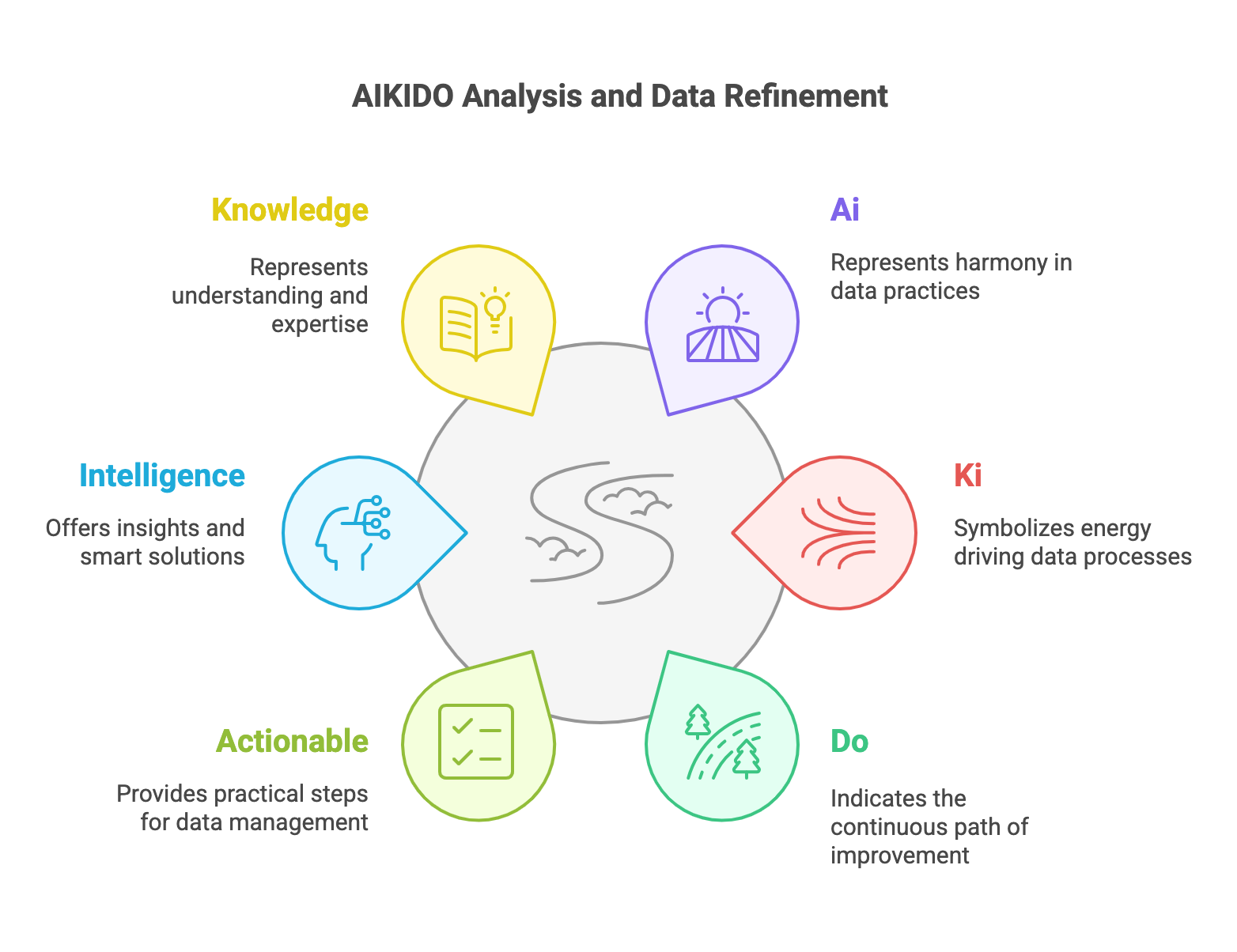
AIKIDO Automation Philosophy
AIKIDO Automation Philosophy
In today’s fast-paced environment, many organizations wrestle with the challenge of turning raw, scattered data into meaningful, actionable outcomes. This quest often feels like grappling with a formidable opponent—one with seemingly infinite angles of attack (multiple stakeholders, complex technologies, shifting priorities). AIKIDO Analysis offers a way to harness that momentum rather than fight it. But before diving into the layers of Actionable, Intelligence, Knowledge, Information, Data, and Objects, it helps to understand the foundation of Aikido itself.
The Meaning of “Aikido”
Aikido, the martial art, is derived from three Japanese concepts:
- Ai (合) – Harmony or unity: Reflects the idea of blending with an opponent’s energy instead of colliding against it head-on.
- Ki (気) – Energy or spirit: Suggests the vital force that flows through actions, connecting mental intent and physical movement.
- Do (道) – The way or path: Emphasizes a continuous journey of learning and refinement rather than a static endpoint.
When woven together as “Aikido,” these elements symbolize the way of harmonizing energy. Instead of using brute force, you redirect what’s already present—turning complexity into an advantage. In the context of data and automation projects, these principles help us see existing information flows not as obstacles, but as potential pathways for more efficient processes.
Applying “Ai,” “Ki,” and “Do” to Data & Automation
- Ai (Harmony) – Aim for coherence between your organization’s big-picture goals and the raw data you gather. Rather than collecting everything and hoping insight emerges, begin with a clear sense of what truly drives outcomes. Align each data source, team member, and system around a unifying vision.
- Ki (Energy) – Channel the natural momentum your teams already have. If employees live in spreadsheets, integrate and automate those spreadsheets; if hardware sensors generate real-time logs, build on those logs. This shared “energy” is the fuel for your project, and thoughtful data strategies help it flow effectively.
- Do (The Way) – Treat each project as part of a continuous journey. Data and technology will evolve; so should your approach. Each iteration is a step along “the way,” allowing you to refine your methods, adopt new tools, and guide the organization forward with agility.
The AIKIDO Layers
With the spirit of Aikido in mind, “AIKIDO Analysis” maps perfectly onto six layered concepts. They transform raw data into purposeful action:
- Actionable – Decisions, alerts, or triggers that directly influence day-to-day operations.
- Intelligence – Aggregated insights, predictive models, or strategic dashboards that inform broader perspectives.
- Knowledge – Domain-specific interpretation: data translated into context, such as why certain customer segments behave differently.
- Information – Organized, labeled data that becomes shareable and comprehensible (for instance, standardized spreadsheets or database tables).
- Data – The raw facts: logs from machines, website clicks, financial entries, and more.
- Objects – Physical or virtual entities (servers, software applications, devices, manual forms) that produce or interact with the data.

High-Level Principles: Harmonizing with the Flow
- Work With What Exists: Instead of forcing new processes, tap into your team’s current workflows and tools.
- Focus on the Vital Few: Don’t attempt to measure and automate everything—zero in on the data that matters most.
- Iterate for Impact: Small, strategic moves (like an automated alert) can ripple through the entire system, bringing major benefits with minimal effort.

Two Pathways Through AIKIDO Analysis: A Fluid, Iterative Approach
Aikido practitioners seamlessly transition between engagement angles to maintain balance and flow. In the same spirit, AIKIDO Analysis can be viewed from two perspectives—“High-to-Low” and “Low-to-High.” Although these may seem like separate paths, real-world analytics often requires moving back and forth between them in a natural rhythm. By toggling between the big-picture goals (Ai: harmony) and the details on the ground (Ki: energy), organizations follow a continuous path (Do: the way) of discovery and improvement.
High-to-Low
- Define Actionable Outcomes
Start by clarifying what you want to achieve—perhaps reducing product returns or improving donor engagement. - Map Intelligence & Knowledge
Determine the predictive models or domain insights you need. - Structure Information & Gather Data
Decide how to label or format raw facts so they’re coherent and relevant. - Pinpoint Objects
Identify which systems, devices, or manual processes generate the needed data.
This pathway is most intuitive when the end goal is already clear. You break down the objective into the insights and raw information you need, then trace your steps all the way down to the hardware, software, or personnel on the frontline.
Low-to-High
- List Objects & Inventory Data
Start with the tangible systems or logs already in use—like IoT sensors or CRM exports. - Transform to Information
Convert disparate data into standardized structures for clarity. - Generate Knowledge & Intelligence
Uncover meaningful patterns or predictive trends using domain expertise and analytics techniques. - Define Actionable Steps
Decide what triggers or decisions you’ll automate based on these insights.
When abundant raw data is already on hand, working from the ground up often makes sense—letting existing assets naturally guide your analyses and uncover new opportunities.
Embracing Fluid Movements Between Perspectives
In practice, few projects follow a strictly linear path. Teams often revisit strategic goals while deep in the data weeds or discover new data sources that reshape their highest-level aims. This iterative, dynamic style mirrors Aikido’s emphasis on adapting to the flow of energy in real time. By flexibly weaving between High-to-Low and Low-to-High approaches, organizations remain agile, anchoring every automation or analytical effort in both a clear overarching vision and the tangible realities of their data.

Practical Scenarios
- Manufacturing Floor Efficiency
- Gather logs from factory machines (Objects & Data).
- Convert them into charts and dashboards (Information).
- Spot downtime patterns (Knowledge & Intelligence).
- Trigger alerts for immediate intervention (Actionable).
- Non-Profit Donor Engagement
- Use donor and volunteer management tools (Objects).
- Merge raw transaction records (Data) with sign-in logs (Information).
- Identify recurring donation patterns (Knowledge & Intelligence).
- Automatically prompt personalized outreach (Actionable).
- E-commerce Inventory Management
- Start with different fulfillment software and scanners (Objects).
- Unify order logs, stock counts (Data & Information).
- Spot top sellers or seasonal spikes (Knowledge & Intelligence).
- Automate reorders and notify customers of low stock (Actionable).

Conclusion
By weaving together Ai (harmony), Ki (energy), and Do (the way), organizations can embark on a continuous journey of refining their data practices. AIKIDO Analysis itself—Actionable, Intelligence, Knowledge, Information, Data, and Objects—acts as a guide to transform raw inputs into genuine organizational momentum. Through a balanced blend of overarching principles and concrete steps, teams can progress from scattered logs to streamlined workflows in a manner that feels natural, sustainable, and always open to ongoing improvement.
Just as martial artists in Aikido blend with an opponent to redirect their energy, AIKIDO Analysis helps you blend with existing data flows, shaping them into outcomes that resonate with your strategic objectives and technical realities.


